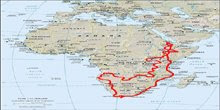We were impressed by the quality of the roads. They are excellent, and where there is roadwork the diversions are clear and good.
What struck us when we arrived was how green, hilly, and productive the countryside looks.
But, what will stay with us the most is the people’s kindness, helpfulness, and their smiles. Uganda is diverse and beautiful: stunning National Parks, thrilling rapids, unique birds, mysterious Chimpanzees and Gorillas, snowy mountains (the Rwenzoris), and active volcanos, tree-climbing lions, crater lakes and Lake Victoria. It is no wonder that this is where Queen Elizabeth and Prince Philip chose to spend their honeymoon 60 years ago.
There are a few cell phone networks available, but Zain, which we used in Kenya and Tanzania is also present in Uganda. We are thus still using the sim card we bought a few months ago.
On 05 May 2009, the exchange rate was more or less:
- Ksh 1 (one Kenyan shilling) to Ush 26 (26 Ugandan shilling)
- USD 1 to Ush 2000
- ZAR 1 to Ush 200
And here are some prices:
- Ush 1700 to 4000 for a beer (supermarket to bar)
- Ush 700 to 1500 for a bottle of Coca Cola (local to Mzungu)
- Ush 1000 for a mango (Mzungu price?)
- Ush 1500 for a dozen bananas
- Ush 2100 to 2400 for 1l of petrol depending on dist from Kampala.
Friday, May 15, 2009
The Source of the White Nile
Jinja, where the White Nile leaves Lake Victoria, was to be our first stop in Uganda. It sells itself as the “Adventure Capital of Africa” and apart from offering probably the best commercial white water rafting in the world, it also offers: quad biking, bungee jumping, horse riding and kayaking. But, we didn’t do any of that - we chilled in the shade and went bird watching instead… Man, am I kicking myself now!

The Source of the Nile
 Bird watching is better than white-water (Murchison Falls)
Bird watching is better than white-water (Murchison Falls)From Jinja we went to Murchison Falls National Park, lower down on the White Nile. The park is a vibrant mix of forest, bush and grassland. Of course we visited the falls and then we spent a day chimpanzee tracking in the Budongo forest.
 Murchison Falls
Murchison FallsIt was magical to experience these creatures in their own environment. We were amazed how they can disappear – we smelled them first when they were only 5m from us and all around us. Our guide, Cypriano, was very knowledgeable and has been working with this particular group of 87 individuals for the last seventeen years. We learned that they only pick fruit from the trees as it becomes ripe (whereas baboons pick everything and throw the unripe fruit down) and can feed off the same few trees for a few weeks. They also hunt monkeys and small antelope closing in on them from all sides. They also strip grass and use it to fish termites out of their nests; and they retreat to the wardens’ village when there is a lion/leopard threatening them.
 Deep Thought
Deep ThoughtThe good news is that this particular forest habitat and its chimp population have been expanding over the last few years.

Chimp Tracking in Budongo Forest
Subscribe to:
Posts (Atom)




